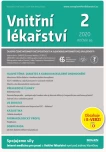Celiac disease in adults
Authors:
Zuzana Vacková
Authors‘ workplace:
II. interní klinika Fakultní nemocnice Plzeň
Published in:
Vnitř Lék 2020; 66(2): 116-120
Category:
Case Report
Overview
Celiac disease is a lifelong autoimmune disorder that occurs in genetically predisposed people when consuming gluten. Its prevalence is around 1% of the population with about twice higher proportion of women. Celiac disease is one of the most common causes of malabsorption, however, its manifestations can be quite diverse – from completely asymptomatic to fully developed malabsorption syndrome. Extraintestinal manifestations are a common finding in adults. The gold standard of diagnosis is the serological detection of specific antibodies (the serum tissue transglutaminase IgA antibodies) in combination with a typical histological finding from a duodenal biopsy. Causal treatment is a lifelong gluten-free diet. Strict adherence to gluten-free diet will reduce the risk of serious complications (intestinal T-cell lymphoma). In the following case report we present a case of a 58-year-old patient, who have been diagnosed with celiac disease at this age based on non-classical symptoms. Specifically, these were multiple pathological fractures from metabolic bone disease due to malabsorption of calcium and vitamin D and subsequent secondary hyperparathyroidism.
Keywords:
Celiac disease – Gluten – gluten‑free diet – malabsorption
Sources
1. Frühauf P, Bronský J, Dědek P, et al. Celiakie – doporučený postup pro diagnostiku a terapii u dětí a dospívajících. Čes‑slov Pediat 2016; 71 (3): 175–183.
2. Caio G, Volta U, Sapone A, et al. Celiac disease: a comprehensive current review. BMC Med17, 142 (2019). Dostupné z DOI: .
3. Češka R. Interna. Praha: Triton, 2010. ISBN 978-80-7387-423-0.
4. Frič P, Keil R. Celiakie pro praxi. Med Praxi 2011; 8(9): 354–359.
5. Schuppan D, Walburga D. Pathogenesis, epidemiology, and clinical manifestations of celiac disease in adults. UpToDate [cit. 2019–11–18].
6. Falt P, Fojtík P, Šmajstrla V. Celiakie – současný pohled na etiopatogenezi, diagnostiku a terapii. Kardiol Rev Int Med 2014, 16(3): 219–223.
7. Kelly C. Diagnosis of celiac disease in adults. UpToDate [cit. 2019–11–18].
8. Husová L., Hermanová M. Hepatopatie, celiakie a lymfocytární kolitida. Čes a Slov Gastroent a Hepatol 2007; 61(6): 309–313.
9. Hoffmanová I, Sánchez D, Tlaskalová Hogenová H. Diagnostická úskalí celiakie. Vnitř Lék 2019; 65(1): 24–29.
10. Věstník Ministerstva zdravotnictví České republiky. Ročník 2011, částka 3. Strana 51–54. Vydáno 28. února 2011.
11. Frič P, Keil R. Celiakie pro praxi. Med Praxi 2011; 8(9): 354–359.
12. Hoffmanová I, Sánchez D, Szczepanková A, Tlaskalová Hogenová H. The Pros and Cons of Using Oat in a Gluten‑Free Diet for Celiac Patients. Nutrients. 2019, 11, 2345.
13. Postupy a stanoviska Státní zemědělské a potravinářské inspekce. Označování potravin z hlediska obsahu lepku. Zveřejněno 6. 4. 2016.
14. Ciclitira P. Management of celiac disease in adults. UpToDate [cit. 2019–11–18].
Labels
Diabetology Endocrinology Internal medicineArticle was published in
Internal Medicine

2020 Issue 2
Most read in this issue
- Differential diagnosis of hypoglycemia
- Hypoxemia/hypoxia and new concepts of oxygen therapy in intensive care
- Thymoma – diagnostics options
- Diosmin/hesperidin: a cooperating tandem, or is diosmin crucial and hesperidin an inactive ingredient only?
